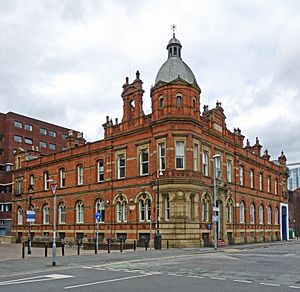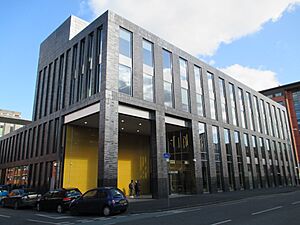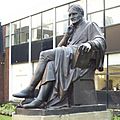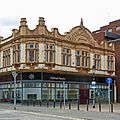Manchester Metropolitan University facts for kids
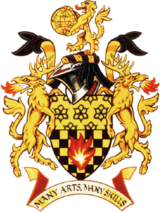
|
||||||||||
|
Former name
|
Manchester Polytechnic | |||||||||
|---|---|---|---|---|---|---|---|---|---|---|
| Motto | Many Arts, Many Skills | |||||||||
| Type | Public | |||||||||
| Established | 1992 – Manchester Metropolitan University Predecessor institutions: 1970 – Manchester Polytechnic 1956 – Manchester College of Science and Technology 1918 – Manchester Municipal College of Technology 1892 – Manchester Municipal Technical School 1883 – Manchester Technical School and the Manchester Mechanics' Institution 1838 – Manchester School of Design 1824 – Manchester Mechanics' Institution |
|||||||||
| Endowment | £1.46M (2021) | |||||||||
| Chancellor | Antony Jenkins | |||||||||
| Vice-Chancellor | Malcolm Press | |||||||||
| Students | 39,095 (2022/23) | |||||||||
| Undergraduates | 29,890 (2022/23) | |||||||||
| Postgraduates | 9,210 (2022/23) | |||||||||
| Location |
,
England, UK
53°28′N 2°14′W / 53.47°N 2.24°W |
|||||||||
| Campus | All Saints, Birley Fields | |||||||||
| Scarf |
|
|||||||||
 |
||||||||||
Manchester Metropolitan University, often called Manchester Met, is a big university in the heart of Manchester, England. It's a place where about 40,000 students learn and grow. Over 4,000 people work there to help students. Manchester Met has four main schools, called faculties, where students can study many different things. It is one of the largest universities in the whole United Kingdom.
Contents
History of Manchester Met
Manchester Metropolitan University has a long and interesting history. It grew from many different colleges that taught special subjects like art, design, and technology.
Early Beginnings
The university's story began way back in 1824 with the Manchester Mechanics Institute. This was a place where working people could learn about science in their free time. Soon after, in 1838, the Manchester School of Design was started. Famous painter L. S. Lowry studied here after World War I.
Over the years, more schools joined, like those for business, education, and home economics. By 1970, many of these schools came together to form Manchester Polytechnic.
Becoming a University
On September 15, 1992, Manchester Polytechnic officially became Manchester Metropolitan University. This was a big step, giving it full university status. After this, more colleges joined Manchester Met, including the Manchester School of Physiotherapy.
The university's logo shows six spade-irons. These symbols come from the university's coat of arms. They represent hard work and strong foundations.
University Campus
Manchester Met's main campus is in the city centre of Manchester. It's a modern place where students learn and live.
Campus Locations Over Time
In the past, the university had seven different locations. Five were in Manchester and two were in Cheshire. To make things simpler, the university decided to bring most of its activities to the main city centre campus. Many older campuses, like Didsbury and Crewe, closed down. This helped create a more connected learning environment.
What Students Study
Manchester Met has four main faculties, which are like big schools. Each faculty focuses on different subjects.
Arts and Humanities
This faculty is home to over 11,000 students. It includes the famous Manchester School of Art (started in 1838) and the Manchester School of Architecture. Students here can study many creative subjects. These include design, fashion, writing, architecture, languages, and history.
Business and Law
More than 10,000 students are part of the Business and Law faculty. It has a Business School and a Law School. The Business School is highly respected, with special awards that show its quality. This faculty also offers many apprenticeship programs. These programs let students learn and work at the same time.
Health and Education
About 9,000 students study in the Faculty of Health and Education. It's located in the Brooks building. Students here learn about important jobs like nursing and teaching.
Science and Engineering
Over 6,000 students are in the Science and Engineering faculty. They study nearly 100 different subjects. A new, modern building for this faculty opened in 2024. It has special labs and study areas for students.
University Library
The university library is a great place for students to study. It has many books and resources. It also has special collections, like old greeting cards. The North West Film Archive, which keeps old films, is also managed by the university library. In 2021, the Manchester Poetry Library opened, offering a space for poetry lovers.
Students can use the library 24/7 during term times. Visitors can also use it on weekends.
Campus Improvements
Manchester Met has invested a lot of money to make its campus even better. Between 2017 and 2024, over £379 million was spent on new buildings and improvements. This included new spaces for Arts and Humanities, Science and Engineering, and a new School of Digital Arts (SODA).
How Manchester Met is Run
Like most universities in the UK, Manchester Met has a Chancellor, who is like a ceremonial head. The main leader is the Vice-Chancellor, currently Malcolm Press.
University Leadership
The university has a Board of Governors. This group makes sure the university follows its rules and uses its money wisely. They set the main goals for the university. The Vice-Chancellor and a team of leaders manage the day-to-day running of the university. They make sure policies are followed and everything runs smoothly.
Manchester Met has around 40,000 students. This makes it one of the largest universities in the UK. The university also employs over 4,000 staff members.
Academic Achievements
Manchester Met is known for its strong academic programs and research.
University Rankings
| National rankings | |
|---|---|
| Complete (2021) | 50 |
| Guardian (2021) | 57 |
| Times / Sunday Times (2021) | 46= |
| Global rankings | |
| ARWU (2020) | 601–700 |
| QS (2021) |
643= |
| THE (2021) | 601–800 |
| British Government assessment | |
| Teaching Excellence Framework | Silver |
The university is very popular, being the fifth most chosen university in the UK by students in 2023/2024.
Manchester Met is also recognized for its excellent research. About 30% of its research is considered "world-leading." Its Business School has special awards, putting it among the best business schools globally. The university works hard to be a welcoming place for everyone.
Research Areas
The university has fourteen research centres. These centres focus on many different topics. Some areas of research include:
- Advanced Materials and Surface Engineering
- Business Transformations
- Bioscience Research
- Creative Writing and English
- Ecology and Environment
- Education and Social Research
- Health, Psychology and Communities
- History Research
- Musculoskeletal Science and Sports Medicine
Students' Union
The Students' Union is a group that represents all students at Manchester Met. It is led by five students who are elected by their fellow students. The Union has a shop and a café for students. In 2015, the Students' Union moved into a new building.
Famous People Who Studied Here
Many notable people have studied at Manchester Met or the colleges that became part of it.
Arts and Creative
- John Bishop, comedian
- John Bradley, actor
- Sarah Burton, Creative Director for Alexander McQueen
- Steve Coogan, actor and comedian
- Brian Cosgrove, animator
- Thomas Heatherwick, designer
- Bernard Hill, actor
- Gethin Jones, presenter
- Liz Kessler, writer
- L. S. Lowry, artist
- Martin Parr, photographer
- Heather Peace, actress and musician
- Michelle Yeoh, actress
- John Thomson, actor and comedian
- David Threlfall, actor
- Dame Julie Walters, actress
Business
- Helen Connolly, CEO of New Look
- Paul Hudson, CEO of Sanofi
- Nick Read, CEO of Vodafone Group
- Dame Dianne Thompson, businesswoman
Public sector and law
- Keith Bradley, politician
- Sarah Green, politician
- Patrick Harvie, politician
- Mike Kane, politician
- Afzal Khan, politician
- Rebecca Long-Bailey, politician
- Sylvia Pankhurst, feminist and campaigner
- Grant Shapps, politician
Sport
- Michael Appleton, football manager
- Karen Bardsley, professional footballer
- Kadeena Cox, parasport athlete
- Mark Cueto, former rugby player
- Ashley Giles, former cricketer
- Danny Grewcock, former rugby player
Images for kids
-
The statue of John Dalton by William Theed outside the university's building in Chester Street
See also
- Armorial of UK universities
- List of universities in the UK
- Post-1992 universities


